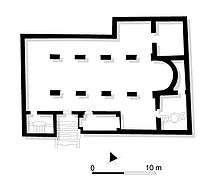Second Battle of Dongola
| Second Battle of Dongola | |||||||
|---|---|---|---|---|---|---|---|
| Part of the early Muslim conquests | |||||||
| |||||||
| Belligerents | |||||||
| Rashidun Caliphate | Makuria | ||||||
| Commanders and leaders | |||||||
| Abdallah ibn Sa'd[1] | Qalidurut[2] | ||||||
| Strength | |||||||
| 50,000 men including cavalry and 3 catapuls [1] |
20,000 cavalry 5,000 infantry 7,000 archers | ||||||
| Casualties and losses | |||||||
| heavy, estimated 30-40,000 | Unknown, estimated 7000 | ||||||
The Second Battle of Dongola or Siege of Dongola was a military engagement between early Arab-Egyptian forces of the Rashidun Caliphate and the Nubian-Christian forces of the kingdom of Makuria in 652. The battle ended Muslim expansion into Nubia, establishing trade and a historic peace between the Muslim world and a Christian nation. As a result, Makuria was able to grow into a regional power that would dominate Nubia for over the next 500 years.
Background
Relations between the kingdom of Makuria and Rashidun Egypt had gotten off to a rocky start in 642 with the First Battle of Dongola. After their defeat, the Arabs withdrew from Nubia and something of a peace had been established by 645.[1] According to the 14th-century Arab-Egyptian historian al-Maqrizi, Makuria did something to violate the truce.[1] It was then that Abdallah ibn Sa'd, the successor of the first governor of Arab Egypt, invaded Makuria in an attempt to bring the Makurians to heel.[1] At this time, northern and central Nubia were united under the Makurian king Qalidurut.[2]
Battle

Abdallah marched a force of 5,000 men, equipped with a catapult, to the Makurian capital of Dongola in 651.[1] He then laid siege to the city,[3] putting his cavalry in the precarious situation of storming a walled city defended by the infamous Nubian archers.[4] An Arab poet describing the battle quotes:[5]
"My eyes ne'er saw another fight like Damqula,
With rushing horses loaded down with coats of mail."
During the battle the town's cathedral was damaged by catapult fire.[1] The casualties incurred by Abdallah's forces were heavy,[4] particularly to his cavalry,[6] and Qalidurut did not sue for peace.[1] In the end, Abdallah called off the siege and negotiated the baqt,[2] one of the most famous documents in medieval history.[5]
The Aftermath and the Baqt
The details of the second Battle of Dongola are scarce, but we do know that the forces of the caliphate suffered enough casualties that taking their objective - the city of Dongola - was no longer possible.[4] A negotiated truce known as the Baqt was agreed upon by both sides and lasted for six centuries.[7] It set up trade relations between Muslim Egypt and Christian Nubia. It involved the exchange of wheat, barley, wine, horses and linen from Egypt for 360 slaves per year from Nubia.
Nubia's Position in the Muslim World
The baqt was without precedent in the early history of Islam. Also new to the paradigm of Muslim-Non Muslim Relations was Nubia's status as a land free from conquest. Traditionally, Nubia was made the exception.[1] It was a Christian region where its rulers did business with Muslim rulers on equal terms well until the 12th century when the power of Nubia began to wane. As a result of the battle and the baqt, Christian Nubia had the space to flourish for the next 600 years.[1]
See also
References
Sources
- Adams, William (1977). Nubia: corridor to Africa. Princeton: Princeton University Press. pp. 824 Pages. ISBN 0-691-09370-9.
- Burns, James McDonald (2007). A History of Sub-Saharan Africa. Cambridge: Cambridge University Press. p. 418. ISBN 0-521-86746-0.
- Clark, Desmond J.; Roland Anthony Oliver; J.D. Fage & A.D. Roberts (1975). The Cambridge History of Africa Volume 2 c. 500 B.C. - A.D. 1050. Cambridge: Cambridge University Press. p. 847. ISBN 0-521-21592-7.
- Hrbek, I. (1988). UNESCO General History of Africa, Vol. III: Africa from the Seventh to the Eleventh Century (Abridged Edition). Berkeley: University of California Press. pp. 399 Pages. ISBN 0-85255-093-6.
- Jennings, Anne M. (1995). The Nubians of West Aswan: Village Women in the Midst of Change. Boulder: Lynne Rienner Publishers. pp. 179 Pages. ISBN 1-55587-592-0.
- Kissling, H.J. (1969). The Muslim World A Historical Survey Part III, The Last Great Muslim Empires. Leiden: BRILL. pp. 302 Pages. ISBN 90-04-02104-3.